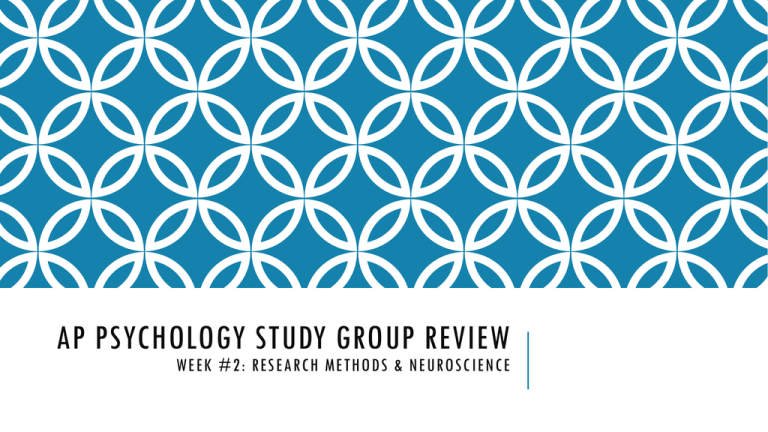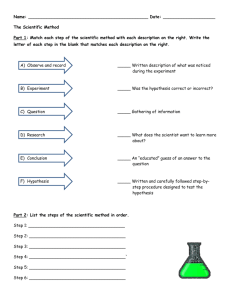AP Psychology Study Group Review Week #2
advertisement

AP PSYCHOLOGY STUDY GROUP REVIEW WEEK #2: RESEARCH METHODS & NEUROSCIENCE RESEARCH METHODS REVIEW GROUP DISCUSSION QUESTIONS: What’s is/are the difference(s) between hindsight bias, overconfidence, and researcher bias? 2. What is “critical thinking” and why is it important to the research process? 3. What are operational definitions and what is the purpose of them? 1. COMPARE & CONTRAST THE TYPES OF RESEARCH: Case Study Strengths Weaknesses Survey Strengths Weaknesses Naturalistic Observation Strengths Correlational/ Experiment Weaknesses Strengths Weaknesses OUTLINE THE SCIENTIFIC METHOD, IN ORDER: Step 1: ______________________________ Step 2: ______________________________ Step 3: ______________________________ Step 4: ______________________________ Step 5: ______________________________ Step 6: ______________________________ GROUP DISCUSSION QUESTIONS: 1. How is random sampling conducted? Give an example. 2. What is the purpose of random sampling? 3. How is random assignment conducted? Give an example. 4. What is the purpose of random assignment? ROUND-ROBIN: CREATE AN EXPERIMENT SCENARIO AND GIVE AN EXAMPLE OF EACH OF THE FOLLOWING CONCEPTS… Independent variable Dependent variable Confounding variables Placebo effect Single-blind procedure Double-blind procedure Experimental group Control group IDENTIFY THE FOLLOWING CENTRAL TENDENCIES: Mean Median Mode MEASURES OF VARIATION: 1. What is “range” as in measures of variation? 2. What is the purpose of standard deviation? 3. Look at Table 2.4 on page 39 to review the equation for standard deviation. (Rarely will you be required to compute a standard deviation problem on the AP Psych Exam…(i.e. once every 4 or 5 years). 4. What is statistical significance? Why is it important in correlational (experimental) studies? ETHICS IN RESEARCH 1. What things should be completed/done BEFORE a research study begins in regards to ethics? 2. What things should be ensured DURING a research study to ensure proper ethics? 3. What things should be completed/done AFTER a research study in regards to ethics? FRQ PRACTICE: Imagine that you are a sports psychologist interested in the usefulness of a new visualization technique that has been developed for Olympic divers. You have decided to conduct an experiment to determine if the technique is effective. Discuss the importance of each of the following in regard to the experiment you are designing: population, sample, hypothesis, independent variable, dependent variable, operational definitions, control group, random assignment, and replication. GRADING RUBRIC FOR THE PREVIOUS FRQ: Point 1- Population: The student must make clear that the population is the group of individuals that the participants are drawn from. In this case, the population is Olympic divers (or some subset of Olympic divers). Point 2 - Sample: The student must recognize that the sample is the group of Olympic divers that is selected for this experiment. The sample must be random so the results of the experiment can be generalized to the population. Point 3 - Hypothesis: The student must explain that the hypothesis is the statement of expectation about the outcome of the experiment. In this case, the hypothesis is that the new visualization technique will produce better dives. The student may state the null hypothesis, such as: “There is no difference between groups of Olympic divers.” Students must state the hypothesis for this particular experiment; a basic definition of “hypothesis” alone should not earn the point. GRADING RUBRIC CON… Point 4 – Independent variable: The student must be aware that the independent variable is the variable manipulated by the experimenter. In this case, the IV is whether or not a diver is taught the new visualization technique. Students must state the independent variable for this particular experiment; a basic definition of “independent variable” alone should not earn the point. Point 5 – Dependent variable: The student must be aware that the dependent variable shows the effect of the independent variable. In this case, the dependent variable is the quality of the dives. Again, students must state the dependent variable for this particular experiment to earn the point. Point 6 – Operational definitions: To earn this point, the student must explain exactly how the dependent variable will be measured. The clearest way to do this is with diving scores. GRADING RUBRIC CON… Point 7 – Control group: The student must explain the need for a group to which results of the visualization group may be compared. In this case, the control group would be a similar group of divers that is not trained in the new technique. Point 8 – Random assignment: The student must understand the importance of randomly assigning participants to the visualization and control groups. This allows the experimenter to assume that the only difference between the divers in the two groups is whether or not they are taught the visualization technique. Point 9 – Replication: The student must explain that experimental results are not fully accepted until the experiment is repeated. If the experiment cannot be replicated, the results were probably caused by chance instead of by the independent variable. NEUROSCIENCE REVIEW VOCABULARY CHALLENGE GUESS THE TERM/CONCEPT/THEORY: This is the principle that information is often simultaneously processed on separate conscious and unconscious tracks. ANSWER: DUAL PROCESSING GUESS THE TERM/CONCEPT/THEORY: This is a condition that results from surgery that isolates the brain’s two hemispheres by cutting the fibers… ANSWER: SPLIT BRAIN GUESS THE TERM/CONCEPT/THEORY: This is the brain’s ability to change, especially during childhood, by reorganizing after damage or by building new pathways based on experience. ANSWER: PLASTICITY GUESS THE TERM/CONCEPT/THEORY: This is the formation of new neurons… ANSWER: NEUROGENESIS GUESS THE TERM/CONCEPT/THEORY: This area of the brain controls language reception (comprehension and expression); usually in the left temporal lobe. ANSWER: WERNICKE’S AREA GUESS THE TERM/CONCEPT/THEORY: This is the area at the front of the parietal lobes that registers and processes body touch and movement sensations…. ANSWER: SENSORY CORTEX GUESS THE TERM/CONCEPT/THEORY: These are cells in the nervous system that support, nourish, and protect neurons… ANSWER: GLIAL CELLS GUESS THE TERM/CONCEPT/THEORY: This is the doughnut-shaped neural system located below the cerebral hemispheres; associated with emotions and drives; includes the hippocampus, amygdala, and hypothalamus. ANSWER: LIMBIC SYSTEM GUESS THE TERM/CONCEPT/THEORY: This is located at the base of the brainstem and controls heartbeat and breathing. ANSWER: MEDULLA GUESS THE TERM/CONCEPT/THEORY: This is the endocrine system’s most influential glad. It regulates growth and controls other endocrine glands. ANSWER: PITUITARY GLAND PARTS AND FUNCTIONS OF NEURONS DISCUSS THE FUNCTION OF EACH LABELED PART WITHIN YOUR GROUP… PARTS AND FUNCTIONS OF THE BRAIN DISCUSS THE FUNCTION OF EACH LABELED PART OF THE BRAIN… GROUP DISCUSSION: Differentiate between the function(s) Broca’s area and the Wernicke’s area of the brain. GROUP DISCUSSION (BE THOROUGH): 1. Which parts of the brain are activated when an individual is verbally threatened and a weapon is pointed at him/her (***hint: vision, hearing, language, danger)? 2. Which parts of the brain are activated when an individual turns on a light in a dark room and suddenly hears a loud exclamation: “Happy Birthday!!!” (***hint: vision, hearing, alert/surprise)? 3. Which parts of the brain are activated when an individual takes a morning jog and notices a small kitten in the middle of the road purring (***hint: vision, emotion)? 4. Which parts of the brain are activated when an individual is dreaming? (***hint: vision, dreamstate) 5. Which parts of the brain are activated when an individual first notices an attractive person, with whom they would enjoy a date, is smiling directly at them? (***hint: vision, emotions, heartrate, sexual alertness) VIDEO CLIP: PHINEAS GAGE (EFFECTS OF BRAIN INJURY TO THE FRONTAL LOBE) https://www.youtube.com/watch?v=us8nNoGXAc8 NEUROTRANSMITTERS & AFFECT OF DRUGS ON THE BRAIN GROUP DISCUSSION: WHAT IS THE FUNCTION OF THE FOLLOWING NEUROTRANSMITTERS? Acetylcholine (ACH) Dopamine Serotonin Norepinephrine GABA (gamma-aminobutyric acid) Glutamate GROUP DISCUSSION (USE YOUR TEXTBOOKS): WHAT HAPPENS WHEN THESE NEUROTRANSMITTERS INCREASE OR DECREASE? 1. An undersupply of serotonin leads to this psychological disorder… 2. When ACh deteriorate/decrease, which neurological disease develops? 3. When dopamine increases to an excess, which psychological disorder develops? 4. When dopamine decreases, which physiological disorder develops? 5. Seizures, tremors, and insomnia are the results of a decrease in this neurotransmitter… 6. An oversupply of this neurotransmitter leads to migraines or even seizures… GROUP DISCUSSION: Differentiate between the functions of AGONISTS and ANTAGONISTS. GROUP DISCUSSION: 1. What effect would AGONISTS have on the brain? 2. Name some agonistic drugs. 3. What effect would ANTAGONISTS have on the brain? 4. Name some antagonistic drugs. SAMPLE MULTIPLE CHOICE QUESTIONS QUESTION #1: Damage in the hippocampus would result in A) difficulties with balance and coordination. B) memory problems. C) the false sensation of burning in parts of the body. D) emotional outbursts. ANSWER: B – Memory problems QUESTION #2: Brain plasticity refers to the a) Feel of healthy human brain tissue. b) Ability of the brain to transfer information from one hemisphere to the other. c) Way a brain gets larger as a child grows. d) Wide variety of functions performed by the human brain. e) Ability of brain tissue to take on new functions. ANSWER: E – ability of brain tissue to take on new functions. QUESTION #3: The support cells that provide nourishment and help the brain in numerous other ways are called A) neurons B) Interneurons C) glial cells D) endocrine cells E) myelin cells ANSWER: C – Glial cells QUESTION #4: The reward deficiency syndrome argues that addictive disorders may be partially explained by genetic flaws in the A) brainstem. B) cerebral cortex. C) limbic system. D) endocrine system. E) cerebrum. ANSWER: C – limbic system QUESTION #5: A PET scan best allows researchers to determine… A) the presence of tumors in the brain. B) electrical activity on the surface of the brain. C) the size of the internal structures of the brain. D) the location of strokes. E) the functions of various brain regions. ANSWER: E – the functions of various brain regions






